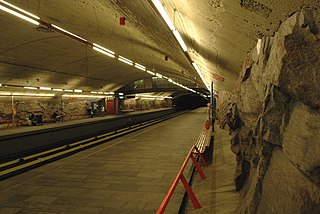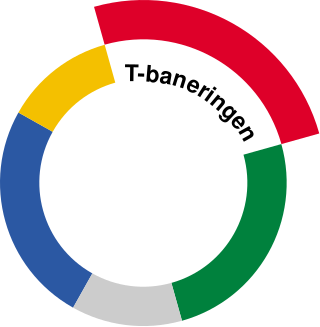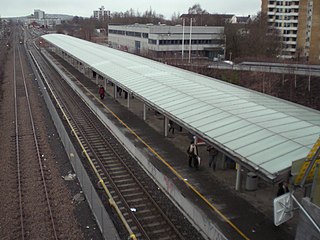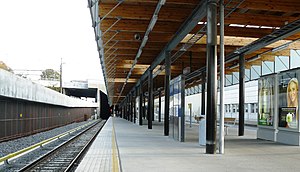
Sinsen is a mixed residential and commercial area in Grünerløkka borough of Oslo, Norway. The westernmost part of Sinsen is part of the borough Nordre Aker.

Nordre Aker is a borough of the city of Oslo, Norway.

The Oslo Metro is the rapid transit system of Oslo, Norway, operated by Sporveien T-banen on contract from the transit authority Ruter. The network consists of five lines that all run through the city centre, with a total length of 85 kilometres (53 mi), serving 101 stations of which 17 are underground or indoors. In addition to serving 14 out of the 15 boroughs of Oslo, two lines run to Kolsås and Østerås, in the neighboring municipality of Bærum. In 2016, the system had an annual ridership of 118 million.

Stortinget is an underground rapid transit station on the Common Line of the Oslo Metro, Norway. It is located in the heart of the city center, next to the Parliament of Norway Building (Stortinget). The station is served by all of the five lines of the metro. At the street level, the station serves tram routes 11, 12, 13, 17, 18 and 19. Lines 11, 12 and 13 serves Øvre Slottsgate on the Vika Line while Lines 17, 18 and 19 stops at Tinghuset in the Ullevål Hageby Line. Also close to the station, there is a stop named Prof. Aschehougs gate that stops line FB5 to Oslo Airport, Gardermoen. Stortinget is 'kilometer marker zero' for the metro network and is owned by Sporveien T-banen.

The Grorud Line is a 13.0-kilometer long (8.1 mi) line on the Oslo Metro between Tøyen and Vestli in Oslo, Norway. Built as a mix of underground, at ground level and as an elevated line, it runs through the northern part of Groruddalen, serving such neighborhoods as Grorud, Romsås and Stovner. Line 5 runs along the entire line four times per hour. Line 4 runs between Vestli and Økern before branching off on the Løren Line to get onto the Ring Line. With 40,000 daily riders, the Grorud Line is the busiest branch of the metro.

The Sognsvann Line is a rapid transit line on the Oslo Metro of Norway. It branches from the Common Tunnel at Majorstuen and runs 6.0 kilometers (3.7 mi) to Sognsvann. After Ullevål stadion, the Ring Line branches off. The Sognsvann Line serves the northwestern and northern neighborhoods of Oslo, mostly within the borough of Nordre Aker. The line is owned and maintained by Kollektivtransportproduksjon and has nine stations. The western end of line 5 serves the entire line. Line 4 and the eastern end of line 5 serve the southern part of the line up to Ullevål stadion before branching off and continuing along the Ring Line. This gives an average five-minute headway on the southern part and an average fifteen-minute headway on the northern part of the line.

The Ring Line is the newest rapid transit loop line of the Oslo Metro of Oslo, Norway. It connects to the Sognsvann Line in the west and the Grorud Line in the east; along with these two lines and the Common Tunnel, the Ring Line creates a loop serving both the city centre and Nordre Aker borough. The 5.0 kilometres (3.1 mi)-long line has three stations: Nydalen, Storo and Sinsen. Four-fifths of the line runs within two tunnels, with the 1.0-kilometer (0.62 mi) section between Storo and Sinsen, including both stations, being the only at-grade part. The line connects to the Grorud Line north of Carl Berners plass and with the Sognsvann Line north of Ullevål stadion.

Forskningsparken is a rapid transit station on the Sognsvann Line of the Oslo Metro. It also serves as a light rail station for the Ullevål Hageby Line of the Oslo Tramway. It is located at the north of the Blindern campus of the University of Oslo in the Nordre Aker borough of Oslo, Norway. The decision to build the station was made in 1998, and it opened in 1999, replacing the former station Vestgrensa, and allowed interchange between the metro and the tramway. The Ullevål Hageby Line was at the same time extended to serve the new Rikshospitalet. Forskningsparken is served by lines 4 and 5 of the metro, each operating every 15 minutes and providing services along both the Sognsvann Line and the Ring Line. Lines 17 and 18 of the tramway serve Forskningsparken, operating to Rikshospitalet and the city center.

Carl Berners plass is an underground rapid transit station located on the Grorud Line of the Oslo Metro, and a tram stop on the Sinsen Line of the Oslo Tramway. The square also has a bus stop for lines 20, 21, 31 and 33. Located at Helsfyr in Oslo, Norway, the area has a mixture of apartment buildings and small businesses. The station is the first metro station on the Grorud Line after it branches off from the shared Common Tunnel. North of the station, the Ring Line branches off from the Grorud Line. The station is served by line 5 of the metro and Line 17 of the tramway, with four hourly departures during regular hours. The tram operates every 10 minutes during regular hours.

Storo is a rapid transit station on the Ring Line of the Oslo Metro, and a tram station on the Grünerløkka–Torshov Line of the Oslo Tramway. It is located at Storo in the Nordre Aker borough of Oslo, Norway. The tram station opened on 28 November 1902, and the rapid transit station on 20 August 2003. Metro lines 4 and 5 run to the station. The tram station serves lines 11, 12 and 18. The station is within walking distance of Grefsen Station on the Gjøvik Line. The station also functions as a bus hub, being located along Ring 3. Storo is a mixed commercial and residential area, and a shopping center is located just north of the subway station.

Nydalen is a rapid transit station on the Ring Line of the Oslo Metro. It is located at Nydalen in the Nordre Aker borough of Oslo, Norway. The station opened on 20 August 2003, as part of the first section of the Ring Line to Storo. The station is served by lines 4 and 5 of the metro, as well as several local bus services. Artistic effort was put into the construction of the station, and the escalators were built into the Tunnel of Light exhibition. Close by the station is the BI Norwegian Business School (BI) campus and several large working places.

Berg is a station on the Sognsvann Line of the Oslo Metro in Norway. Located between Ullevål stadion and Tåsen stations, it is the first station after the Ring Line leaves the Sognsvann Line. The station is located 6.1 kilometres (3.8 mi) from Stortinget station. Berg is amongst the original stations on the line, and was opened on 10 October 1934. It was upgraded and rebuilt in the 1990s, when the Sognsvann Line was upgraded from light rail to rapid transit standard. Three accidents have taken place at Berg station, the latest in 2008. The area around the station is mainly residential. Berg Upper Secondary School is located approximately 100 metres (330 ft) from the station.

AS Oslo Sporveier is a defunct municipal owned company responsible for public transport in Oslo, Norway. It was created in 1924 to take over the city's two private tram companies. In 1927 its started with bus transport, including from 1940 to 1968 trolleybuses. Since 1966 rapid transit and from 1985 water buses have also been operated by the company. It was split into two separate companies in 2006; Kollektivtransportproduksjon took over the operation while Oslo Public Transport Administration was responsible for buying the services, fare regulation and marketing. The latter merged into Ruter in 2008, when the Oslo Sporveier brand was discontinued.

Grefsen station is a railway station at Storo in Oslo, Norway on the Gjøvik Line. From the station there is also a short railway, the Alnabru–Grefsen Line, to Alna on the Hoved Line. The station is located 6.82 km from Oslo Central Station and is located between Tøyen and Nydalen at 109.2 metes above sea level. It was opened on 20 December 1900, two years before the railway to Gjøvik was finished.

The Løren Line is a 1.6-kilometer (1.0 mi) line of the Oslo Metro. Located entirely underground, it runs through the neighborhoods of Sinsen, Løren and Økern in Bjerke, creating a connection between the Ring Line with the Grorud Line. The line features one station, Løren. It is served by metro trains which run down the Grorud Line and then connect to the Ring Line. It allows for higher capacity on the metro as more passengers a transported via the Ring Line instead of through the congested Common Tunnel. Construction started in June 2013 and the line opened on 3 April 2016.

The Ullevål Hageby Line is a light rail section of the Oslo Tramway. It runs from Stortorvet in the city center of Oslo, Norway to Rikshospitalet. It passes through the areas of St. Hanshaugen, Ullevål Hageby and Blindern before reaching Gaustad. It serves major institutions such as Oslo University College, Bislett Stadion, Ullevål University Hospital, the University of Oslo and Rikshospitalet. The line is served by route 17 and 18 by Oslo Sporvognsdrift using SL95 trams, while the tracks are owned by Kollektivtransportproduksjon.

The Sinsen Line is part of the Oslo Tramway on the east side of the city. Most of the line is served by line 17, although the northernmost tip (Grefsen–Torshov) is served by line 18 which otherwise runs on the Grünerløkka–Torshov Line. Both services use SL95 articulated trams.

The Vika Line is a light rail section of the Oslo Tramway in Oslo, Norway. It runs between Wessels plass, through the neighborhood of Vika and Aker Brygge, before arriving at Solli. The section is served by SL79 trams on line 12. The line is owned by the municipal company Kollektivtransportproduksjon, and operated by its subsidiary Oslo Sporvognsdrift.

The history of the Oslo Tramway and Oslo Metro in Oslo, Norway, starts in 1875, when Kristiania Sporveisselskab (KSS) opened two horsecar lines through the city centre. In 1894, Kristiania Elektriske Sporvei (KES) built the first electric street tramways, which ran west from the city centre. Within six years, all tramways were electric. The city council established Kristiania Kommunale Sporveie (KKS) in 1899, which built three lines before it was sold to KSS six years later. Both KSS and KES were taken over by the municipality in 1924, becoming Oslo Sporveier. The company gradually expanded the city tram network, which reached its peak length in 1939.






















